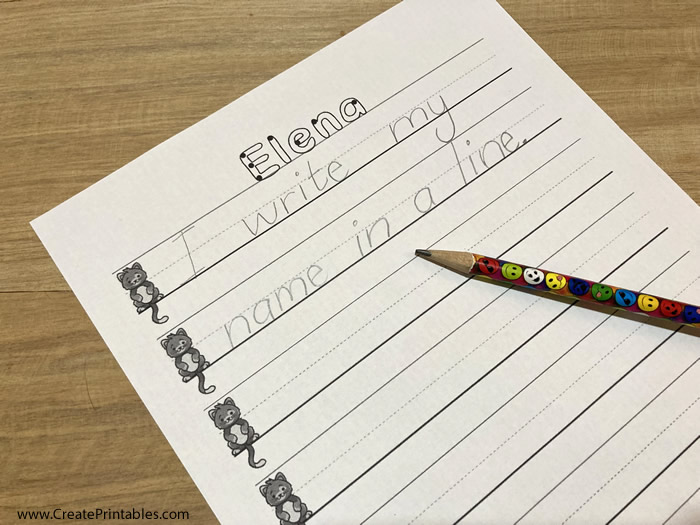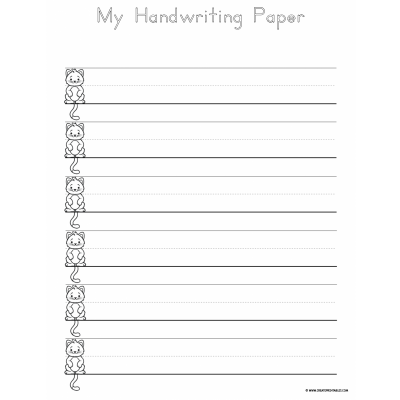Use these handwriting lined pages with a cat for a spacing guide to practice handwriting. The cat image greatly helps kids with their letter spacing when writing and prevents their eyes from getting confused by all the lines on the page.
Positioned between two lines, the top of the ears represent the maximum height a letter should be, and the cat is sitting on the midline to represent the bottom of a letter.
For tricky letters that appear below the line like g, j, and y, a tail hanging underneath helps show early learners the rough size and length of their letter. This printable handwriting practice worksheet can be customized with a variety of line height options such as 1 inch, 1/2 inch, 3/4 inch, 5/8 inch and 1/4 inch.
It’s not just good for beginning writing for kindergarten or preschool; older school age kids who need to work on smaller letter formation or cursive handwriting can use this worksheet too.

Tips for Using this Cat in Handwriting Practice Paper
One thing that’s great about this worksheet is the cats can be printed in black and white or color. If you choose black and white, you’ll get an outline that kids can color in as they work.
Make sure you use a variety of letters when practicing handwriting with your child, especially ones that are trickier to space correctly.
Other tips to make the most of this cat handwriting practice paper:
-
Offer advice, but don’t expect perfection
-
Start with words or letters your child is familiar and build off them
-
Choose the correct line height for your child’s age and stage to avoid frustration
-
Build fine motor skills outside of worksheets to help improve your child’s writing
-
Practice both upper case letters and lower case letters of the alphabet
Spelling Practice
The spaces on this worksheet are big enough for writing words out, too. Work on two skills at once by having your child copy down or attempt to spell age-appropriate words. This is a great way to study for a spelling test, too! Great way to add this to a classroom setting.
Practice Writing Different Sizes
Even once they master the alphabet and letter formation, beginner writers often struggle with the size of their letters. This skill will naturally develop over time, but you can give kids a head start by introducing them to writing in a variety of print sizes.
Cursive Handwriting Practice
This worksheet can also be used to practice writing early cursive letters. The cat guide, especially with the hanging tail, is helpful to show kids where their handwriting should begin and end.
Advanced writers can also benefit from this worksheet; adjust the size to ⅝ inch or ¼ inch lines, then practice writing neat sentences in cursive handwriting.
Draw Cats Instead of Writing Letters
This is a fun activity for kids who need extra help with letter height or just as a fun way to break up writing practice. Instead of writing letters or a word, have the child copy the cat drawing instead.
Kids can be as creative as they want, but make sure they’re following the basic rules: Ears at the top line, feet on the bottom line, and tail hanging almost to the cat below.
Cat Themed Handwriting Practice
Themed worksheets help make learning more fun, especially for reluctant writers. Turn this worksheet into a mini science lesson by having the child write out as many cat themed words as they can think of on the lines.
Younger kids might choose words like ‘ears’ or ‘paws’, while older children can add more complex concepts like breeds (calico, tabby) and species (lion, tiger).
